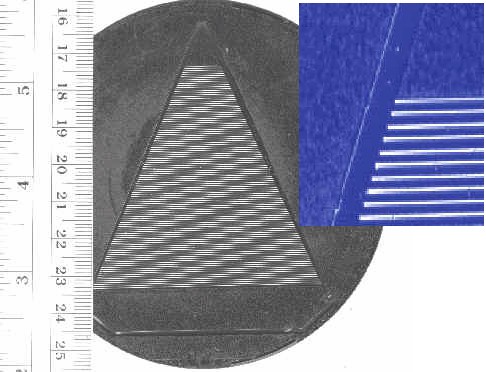X-RAY RUNS: Apply for Beamtime
2017 Nov 1 - Dec 21
2018 Feb 7 - Apr 3
2018 Proposal/BTR deadline: 12/1/17
2018 Apr 11 - Jun 4
2018 Proposal/BTR deadline: 2/1/18
K.D. Finkelstein (CHESS) and Paul Cottle (Cornell
University)
CHESS, always at the cutting edge of innovation in x-ray optics, has
begun exploiting resources at the Cornell Nanofabrication Laboratory to
develop a new generation of focusing elements. The work adapts
micro-electro-mechanical system (MEMS) fabrication techniques to reduce
the size of structures in silicon used to collect, diffract, and focus
x-ray beams.
As a first application, we are improving our sagittal focusing
monochromator crystals that gather and focus a large horizontal swath of
synchrotron radiation. These crystals are thin (~1mm) triangles with
deep rectangular groves (gums) cut perpendicular to the altitude. The
"teeth" adjacent to the gums counteract the anticlastic bending that
occurs due to the sagittal bend. This type of x-ray optic produces a
focal spot limited in size by the synchrotron source (particle beam size
in the storage ring), the sagittal tooth size (individual diffracting
regions on the crystal), and the focal distances. For the typical 1 to 3
focal ratio, a small focal spot requires the tooth width be ¼ of the
source size. If one also wants to maximize flux in the focal spot, it is
important to maximize the number of teeth cut into these crystals.
We are currently making full sized crystals from 4 inch diameter wafers,
with equal gum and tooth widths of 250 microns, containing 125 teeth
approximately 1 mm. tall. These features are smaller than can typically
be achieved with traditional diamond-blade cutting, and with much less
breakage of delicate crystals during processing. This technique produces
virtually no surface damage and so there is no need to use strong acids
to etch away damage.

A triangular crystal is etched out of a 4 inch
silicon wafer. The inset shows the 1mm deep, 250 micron wide grooves
that give the crystal enough flexibility to bend without breaking or
becoming distorted. The light horizontal lines are groove edges.
